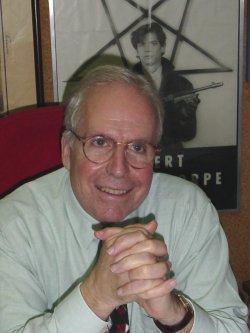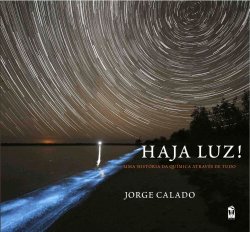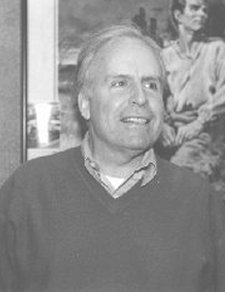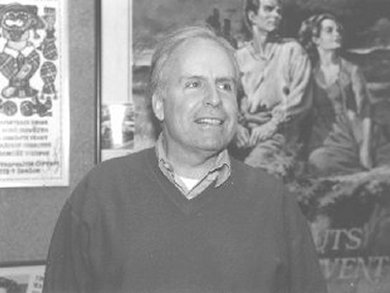Jorge Calado is the author of the fascinating book Haja Luz! Uma História Da Química Através De Tudo (Let There Be Light! – A History of Chemistry Through Everything). Vera Koester spoke with him about what inspired him to write about the history of chemistry from such a unique perspective and how he combines chemistry and art.
What was the idea behind this very fascinating book about the history of chemistry?
The book reflects the way I think and teach. When I was growing up, I had no doubt that I wanted to become a scientist, but I was also very fond of the arts. Much later, when I was teaching (Physical Chemistry, Statistical Mechanics, Chemical Thermodynamics) at university, I found that by drawing on parallels between chemistry and the arts, I could make the subject much more appealing and understandable to the students. I firmly believe that there is no clear distinction between science and the arts. Thanks to the Zeitgeist, a painter or a novelist does chemistry by other means … I was determined to tell the story of chemistry through the lives of the chemists and of those who influenced them through their works and policies, including kings, queens, prime ministers, and revolutionaries.
Conversely, I also wanted to show how science and technology influence the arts. And I chose to tell the story in a non-linear way, never hiding the problems, setbacks and errors. Indeed, I firmly believe that the error, wrong theories, etc., are very important to the development of science. One can learn a lot from those errors. In fact, science progresses by refutation.
So this is the book I had to write: a book where the lives of chemists are mixed up with the lives of writers, painters, composers, philosophers, and politicians. It is all part of the general fabric of life.
It is amazing what you have covered in the book. Where did you get all the material from?
All my life I’ve read a lot, I have a very good library, and I am blessed with a very good memory. I collect first editions of books by famous scientists such as Faraday, Lord Kelvin, van’t Hoff, Nernst, Debye, etc. I even have 17th century publications by Boyle!
I also relied on good university libraries — Oxford, UK, and Cornell, USA, for example. Cornell University, for instance, has the best Lavoisier collection outside France, which I used extensively while writing Chapter 4. Several illustrations for the book also come from that amazing collection.
How long did it take from the idea to the finished book?
 The idea stemmed from a lecture I gave in 2003, entitled “The Day Chemistry Was Born”. I thought that it could be expanded into a 200-page book, to be written in 3–4 months. But as soon as I began to write Chapter 0, “Creation”, I could see that it would take much longer and would be a much bigger book.
The idea stemmed from a lecture I gave in 2003, entitled “The Day Chemistry Was Born”. I thought that it could be expanded into a 200-page book, to be written in 3–4 months. But as soon as I began to write Chapter 0, “Creation”, I could see that it would take much longer and would be a much bigger book.
When I finished it, the typescript had about 850 pages! The final book is over 600 pages long. It took about 7 years to write because of my other commitments: teaching, research, supervision of graduate students and my hobbies — cultural criticism and curatorship of photography exhibitions both in Portugal and abroad.
I am also the music and opera critic for the leading Portuguese newspaper (Expresso), and since starting writing the book I must have curated half-dozen exhibitions (in Lisbon, Paris, Cambridge, Brussels, and Washington, DC), all with catalogues written and produced entirely by me. Some were important exhibitions, like “INGenuity — Photography and Engineering 1846–2006”, for the 50th anniversary of the Calouste Gulbenkian Foundation, in Portugal. This exhibition, which had over 350 photographs from all over the world (and a 650-page catalogue), was also seen in Brussels, in 2007, to great acclaim. Because of all this, there were periods of many months, sometimes even almost a year, when I didn’t write a word for “Haja Luz!”. But I would resume writing after many months, without any problem. I wrote without any planning. The book was already written in my head!
What was most interesting about writing the book?
Frankly, the book was a delight to write. It was also an example of multiple cases of serendipity. I remember a trip to Stockholm, just before I would be writing about Descartes. I was walking aimlessly — as is my habit — through the streets, when I came across a beautiful, isolated church — the Adolf Fredrik Church. I went in and was surprised by a superb neoclassical monument to Descartes, by Sergel, the great 18th century Swedish sculptor. I knew, of course, that Descartes had died in Sweden. I did not know that he had been first buried on this site. In the churchyard there is also the grave of Olaf Palme, the great Swedish Prime Minister, assassinated in 1986. All this found its way into my book, and later I secured a picture of the Descartes monument from the church’s pastor.
Another example of serendipidy, and possibly my favourite story, involves Joseph Priestley, the co-discoverer of oxygen. I knew that a German painter, Johann Eckstein, had been a witness to the looting and destruction, by the mob, of Priestley’s house, laboratory, and church, on July 14th, 1791, and that he had later painted the scene. When I tried to locate the painting, to get permission to reproduce it in the book, I found, to my great surprise, that it was in Lisbon, not very far from where I live. I found out that a great-great-great-grandaughter of Priestley, Susan Lowndes, had married a Portuguese journalist and moved to Portugal in the late 1930s, bringing with her lots of family furniture and artifacts, that painting included. I contacted her son, Paulo Lowndes Marques, who had the painting specially photographed for me. I visited him in his house to look at it, and I also held in my hands the silver tankard that had belonged to Priestley, and from which he had drunk beer.
Which part of the research for your book was the most interesting to you personally?
As I mentioned before, the book was a pleasure to write. It unfolded naturally, without any plan. When I reached the end and went back, to read it from the beginning, I did not have to add or subtract anything. Only polish the phrasing here and there. I also wrote it in such a way that it can be read by anybody, even by someone without any special background in science. People can open it at any point and begin to read. They don’t have to start at the beginning which is an advantage in such a long book.
One of the most interesting parts for me was the section on Mendeleev and the Periodic Table. I knew the generalities about his life, but not in depth. I read some biographies — even Russian ones, in translation — and was amazed by the heroism of his mother, the origins of the Periodic Table (he wanted to write a book on Inorganic Chemistry to earn some money, and had to find a criterium to rationalize a vast assortment of elements, etc.). I also did not know that his daughter, Lyubov, had played such a role in Russian symbolism. She married the poet Aleksandr Blok and had a tumultuous affair with the writer Andrei Bely. In fact, Mendeleev himself had been elected to the Russian Academy of the Arts before he became a member of the Academy of Sciences.
But the aspect that gave me most pleasure was to underline, right from the beginning, the role of the many women in the development of chemistry. In the 18th century alone, besides Mme Lavoisier (and the wives of several other scientists), we have Eva, the Swedish Countess Ekeblad, and the astonishing Emilie, the Marquise de Châtelet, Newton’s translator and Voltaire’s mistress.
The book has many pictures, including some art pictures. Where did this idea come from?
I think in terms of images. This is what people call imagination. I knew from the start, that the book had to be profusely illustrated. Its subtitle is, after all, “A History of Chemistry Through Everything” — where the ‘Everything’ stands for the other sciences, like maths, physics, biology, geology, etc., but also for literature, painting, music, photography, philosophy, economics, the theory of ideas, politics and so on.
I n many cases, I knew which images I wanted (never the obvious ones …). In other cases, they were obtained through very thorough research. It took the best part of a year to obtain the files and reproduction rights from museums, private collections, foundations, or the artists themselves. The book has over 450 images!
n many cases, I knew which images I wanted (never the obvious ones …). In other cases, they were obtained through very thorough research. It took the best part of a year to obtain the files and reproduction rights from museums, private collections, foundations, or the artists themselves. The book has over 450 images!
As for the cover image (right) — a superb photograph by the Australian Phil Hart, showing all kinds of light (the setting Sun, star tracks, lighthouse and bioluminescence), I remembered having seen it when I was doing research for a photography exhibition, but I had not taken any notes on its title or the name of the artist. When it dawned on me that it would make a stunning cover for my book, it took me a while to find it again. The artist, very kindly, provided the image without charging any reproduction fees.
Tell us a bit about how your career has developed, please?
It developed in a very straightforward way. My first degree was in chemical engineering at the Instituto Superior Técnico (IST, Technical University of Lisbon), Portugal. I really wanted to read physics, but, at that time, there was no separate course in physics, only a degree in physics and chemistry. The chemical engineering course provided, then, the best background in physics by covering relativity theory, quantum mechanics, atomic and nuclear physics, etc.
I got my Ph.D. in Oxford, UK, in 1970 in chemistry — actually in low temperature physical chemistry of solutions. I got a position as assistant professor at IST in Lisbon, later associate professor and finally, in 1982, full professor. My research area was the thermodynamics of molecular liquids (both experimental and theoretical), usually at low temperatures and high pressures. More recently, I was involved in the energetics of apatites. In the early 1980s through the late 1990s, I was a visiting professor and, later adjunct professor of chemical engineering at Cornell University, New York, USA. For many years, I was kind of commuting between Portugal and the USA! While at Cornell, I was also invited to give courses on the relations and parallels between the arts and the sciences. These courses were created for me.
What do you enjoy most about your career?
Maybe the ability to harmonize my devotion to science with my love for the arts. I have written about opera for international magazines, about the history and philosophy of science for the Times Literary Supplement, etc., curated some 25 photography exhibitions in Portugal and abroad, and have lectured all over the world. In the late 1980s–early 1990s, I formed, at the request of the Ministry of Culture, the National Collection of Photography, housed in Centro Português de Fotografia, Oporto. In the mid-1970s, I was also the director of the Luso-American Educational Commission, which administers, in Portugal, the Fulbright-Hays program and throughout my career I’ve served on a variety of international science committees (Council of Europe, NATO, INTAS, European Union, etc.).
I am also very proud of the fact that I started scientific research in my field in Portugal, and have supervised dozens of Ph.D. theses. At least 15 of my Ph.D. students are professors at Portuguese and foreign universities.
What else would you like readers of ChemViews to know about you, or the book?
That I am a very happy person. That the book, “Let There Be Light! – A History of Chemistry Through Everything” is an attempt to show that science is created by men and women, with their likes and dislikes, qualities and faults, and that science permeates everything in society. That chemistry, in particular, is useful, funny, dangerous, stimulating, frustrating, and indispensable. Like the arts and sex, chemistry rules our lives.
.jpg)
Above: Even Calado’s portrait from the book shows his love of art and history, being taken in the middle of a neolithic formation of standing stones near Évora, Portugal. © José M. Rodrigues
 Professor Jorge Carreira Goncalves Calado obtained his degree in chemical engineering from the Instituto Superior Técnico (IST, Technical University of Lisbon), Portugal, in 1961. He moved to the University of Oxford, UK, to perform his doctorate under the supervision of L. A. K. Staveley. He returned to IST in 1970 as assistant professor and later associate professor, then full professor in 1982.
Professor Jorge Carreira Goncalves Calado obtained his degree in chemical engineering from the Instituto Superior Técnico (IST, Technical University of Lisbon), Portugal, in 1961. He moved to the University of Oxford, UK, to perform his doctorate under the supervision of L. A. K. Staveley. He returned to IST in 1970 as assistant professor and later associate professor, then full professor in 1982.
In 1980 he began his 18-year long association with the University of Cornell, Ithaca, NY, USA, first as a visiting professor and later as Adjunct Professor of Chemical Engineering.
His research is in the field of thermodynamics of molecular fluids and their mixtures, including the experimental determination of phase equilibria, equations of state, surface properties, etc., under high-pressure conditions (up to 4000 bar) and at low temperature (60–320 K). These studies also include the measurement of isotopic effects and applications to the development and testing of statistical theories for modeling the atmospheres of outer planets and their satellites.
Later he became involved with the energetics of apatites (measurement of standard molar enthalpies of formation and molecular simulations).
His other interests are in seeking to deepen the relationships and parallels between the arts and sciences. His hobbies include cultural criticism (especially in the fields of opera and photography) and curatorship of international exhibitions of photography.
He founded the university press of the Instituto Superior Técnico, IST Press, and was its Director until 2005.
Selected Publications
- Molecular Dynamics Simulations of Monoclinic Apatites: A Universal Equation of State
F. J. A. L. Cruz, J. N. Canongia Lopes, J. C. G. Calado,
Fluid Phase Equil. 2007, 253, 142–146.
DOI: 10.1016/j.fluid.2007.02.018 - Non-ideality of an “ideal” liquid mixture: (36Ar+40Ar)
J. C. G. Calado, F. A. Dias, J. N. C. Lopes, M. Nunes da Ponte, L. P. N. Rebelo,
Phys. Chem. Chem Phys. 2000, 2, 1095–97.
DOI: 10.1039/A910322H - The building-up of phase diagrams
J. C. G. Calado, J. N. C. Lopes,
Pure Appl. Chem. 1999, 71, 1183–96. - The surface tension of nitric oxide and the corresponding states principle
J. C. G. Calado, A. F. M. S. S. Mendonça, B. J. V. Saramago, V. A. M. Soares,
Mol. Phys. 1997, 91, 757–60.
DOI: 10.1080/002689797171247 - Shape effects in molecular liquids: phase equilibria of binary mixtures involving cyclic molecules
J. C. G. Calado, E. J. M. Filipe, L. A. M. Pereira, L. M. B. Dias, R. P. Sear, G. Jackson,
J. Phys. Chem. 1997, 101, 11243–48.
DOI: 10.1021/jp9726551 - Thermodynamic studies of triangular molecules: liquid mixtures of xenon and the boron halides, BF3 and BCl3
J. C. G. Calado, E.J. M. Filipe,
J. Chem. Soc., Faraday Trans. 1996, 92, 215–18.
DOI: 10.1080/002689797171247

- Haja Luz! Uma História Da Química Através De Tudo
Jorge Calado
IST Press, Editora Universitária, 2011.
ISBN: 978-972-8469-85-6.




